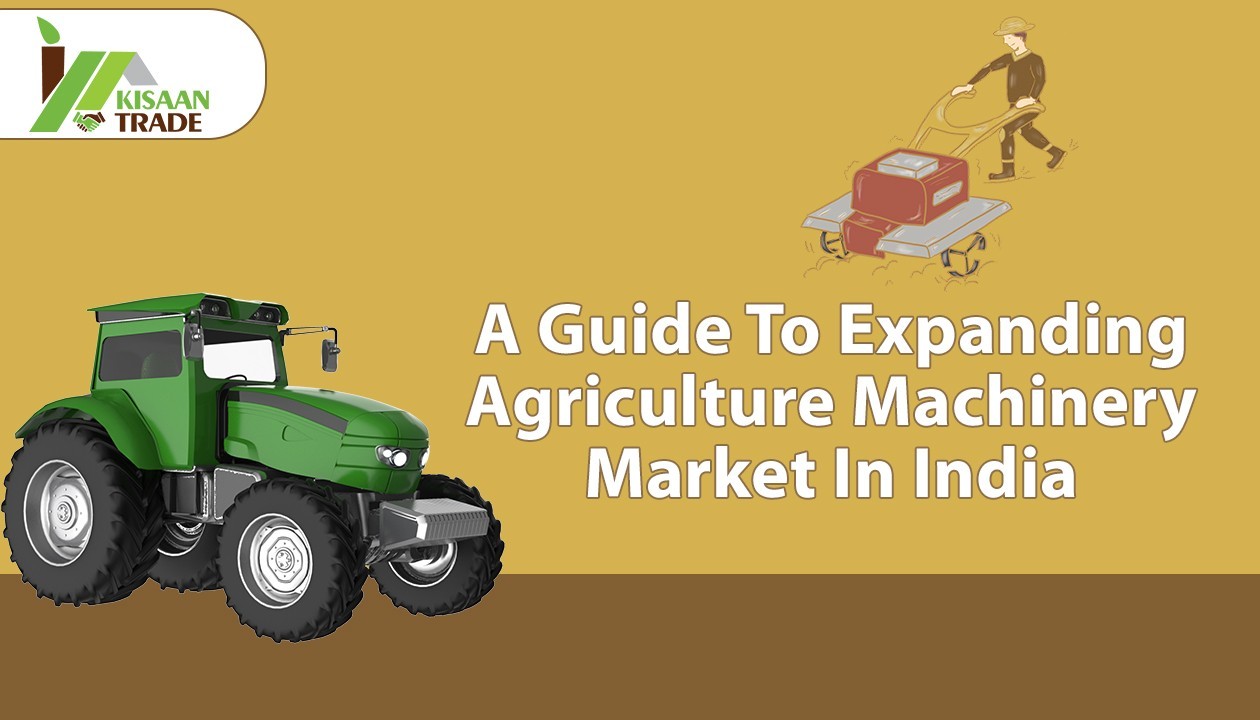A guide to expanding in India's agricultural machinery market
Mar 06, 2023
B2B Trade Portal

Farm mechanisation has made a significant contribution to modern farming. In addition to reducing human labour and development costs, it increases efficiency. Additionally, automation promotes increased productivity through the use of various data sources, worker safety and comfort, improvements in product quality, and an increase in the market value of the product. In addition to enabling farmers to raise a subsequent yield or multiple crops, the best farm machinery aids in increasing production and efficiency, making Indian agribusiness appealing as a lifestyle by turning it into a business rather than a resource. More use of farming data sources and harvest assurance from various sources will be needed for expanded creation.
Mechanization of agriculture is needed in India
A sub-mission on agricultural mechanisation was dispatched in 2014–15 after it was decided that the country needed to develop its agricultural mechanisation sector comprehensively. The plan assists state legislatures in developing and displaying rural mechanisation, assists farmers in acquiring various horticultural tools, and facilitates the establishment of custom hiring centers.
This will necessitate the development and presentation of high-limit, accurate, dependable, and energy-efficient equipment, as well as more significant design sources of information. Looking at the example of land ownership in India, it is clear that 84% of the holdings are smaller than 1 hectare. These types of farmers must make extraordinary efforts in agricultural mechanisation to improve the productivity and creativity of horticulture. The level of peripheral, small, and semi-medium functional property is likely to increase given the current situation of land discontinuity and the shrinkage of normal-sized functional possessions. Individual responsibility for equipment is both economically and functionally unviable with such a small holding. Custom-hire centres of agricultural machinery operated by cooperative societies, self-help groups, and private or rustic businesses are the best option for enabling farmers' easy access to farm equipment and improving agricultural efficiency for the benefit of small and marginal farmers in India.
COVID-19's Effects
To stop the virus's spread, the government imposed a lockdown during FY 2021, which halted all trade, production, and business. The sales volume increased and surpassed that of FY 2020 following the easing of restrictions in the second quarter of FY 2021. In FY 2021, the market continued to be resilient to the pandemic's effects. However, the market was severely affected by the devastating second wave in the first quarter of FY 2022, which led to a significant drop in sales in April and May of 2021. Tractor and other agricultural equipment sales have dropped significantly.
In the second and third quarters of FY 2022, ahead of the domestic holiday season, the market is displaying signs of recovery.
Drivers of the Indian Agricultural Equipment Market
1) Lack of Workforce: Farm mechanisation has become more common among farmers as a result of the labour shortage. There is a labour shortage in rural areas as a result of widespread migration from rural to urban areas and numerous rural employment programmes. For instance, the National Rural Employment Guarantee Agency (NREGA) has caused a cascade effect that has resulted in farm mechanisation in many locations due to a lack of labour. The implementation of this scheme has significantly reduced the inflow of seasonal migrant workers from Bihar and the UP to states such as Haryana and Punjab during the critical sowing and transplanting season. As a result, these states have seen a marked increase in the demand for farm equipment.
2) Ease of Financing: Several banks and microfinance organisations have opened up throughout rural India in recent years. This has made it simple for farmers to get credit to buy farm equipment.
3) Government incentives: The Indian government's incentives in the form of subsidies, reduced import taxes on agricultural equipment, and simple financing plans have also significantly boosted the demand for farm equipment in India.
4) Rising incomes: Over the past few years, rural households' income levels have been steadily rising as a result of the region's robust economic growth and high agricultural productivity. Farmers have been able to significantly increase their spending on agriculture mechanisation thanks to rising incomes.
5) Large Untapped Market: Despite recent years of rapid growth, the penetration of tractors and various related pieces of equipment is still quite low. Future expansion is anticipated to be greatly facilitated by this.
6) Emergence of Contract Farming: Contract farming's emergence is also anticipated to have a significant positive impact on India's agricultural equipment market. With the contractor's assistance, we anticipate that contract farming will allow farmers to benefit from technology, education, and financing. This should make the adoption of mechanised farming practises easier.
Initiatives by the Department of Agriculture and Cooperation
1) Mechanization Advancement and Strengthening through Training, Testing, and Demonstration: This ensures that agricultural equipment is put through its paces during testing, limits the amount of time farmers and end users are required to work, and advances agricultural mechanisation through demonstrations.
2) The Show, Training, and Distribution of Post-Harvest Technology and Management (PHTM) Programme: It aims to encourage innovation for critical handling, self-improvement, minimal expense, logical capacity, and transportation, and the yield result for executives through exhibits, limit farmers' work, and benefit end users.
3) Financial Assistance for the Purchase of Agriculture Equipment and Machinery: Encourages responsibility for horticultural tools and implements in accordance with standards of assistance.
4) Organize Farm Machinery Banks for Custom Hiring: Offers reasonable financial assistance to organise Farm Machinery Banks for Custom Hiring for suitable areas and harvests.
5) Establishing a High-Tech, High-Productive Equipment Hub for Custom Hiring: It gives financial assistance to establish high-tech equipment hubs for high-value harvests like sugarcane, cotton, and other crops.
6) Advancement of Farm Mechanization in Selected Villages: Offers financial assistance to advance appropriate innovations and establish farm machinery banks in reputable cities with low levels of automation.
7) Financial Support to Promote Mechanized Operations/Hectare Utilizing Custom Hiring Centers: This gives recipients financial assistance based on the size of their land parcels, using equipment and supplies sourced from specialised recruiting hubs in sparsely populated areas.
Kisaan Trade
To connect thousands of buyers and sellers dealing in various agriculture input/output categories, Kisaan Trade is among the best B2B marketplaces for agriculture.
Reasons why you should consider selling your products on our website
1. Easy-to-use navigation
To assist customers in finding the products they require quickly, a user-friendly navigation system is essential. We make sure that the products are logically divided into categories, with the most popular ones appearing first. While others shop by category, some people specifically look for products by brand. Their navigation bar features quick links to affordable and discounted goods in addition to this structure.
2. Site Search
Most of the top ecommerce sites offer site search in addition to user-friendly navigation. Customers can skip the navigation and conduct a targeted search instead.
3. Footer Navigation
Have you thought about how to best use the footer of your website to direct customers to your best products? We advise you to test a list of links to the most popular goods, services, and knowledge that customers are looking for.
4. Videos of Products
Conversions can go up if you add video to your product pages. Over 50% of consumers surveyed by Think with Google claimed that watching an online video influenced their choice of brand or product. On their product pages, retailers are free to upload videos and pictures.
5. Product Evaluations
Product reviews and ratings are the most common type of user-generated content found on e-commerce websites. To convince customers that a product will meet their needs, this section of the product page on a website is essential. Customers are able to rate and review products, and these reviews are displayed beneath the product descriptions and sponsored items.
6. Product FAQ
Another way we attempted to incorporate user-generated content into your online store was to compile a list of the most frequently asked customer questions.
There are several ways that this section can benefit your store.
• By responding to the most common pre-sale inquiries about your products from customers, you can increase the number of sales.
• Reduce the time your customer service staff must spend responding to inquiries about products, both before and after the sale.
7. Order Monitoring
When a customer places an order, their main concern is when their order will arrive. Make it simple for customers to access our website and check the status of their orders.
8. Push Notifications
Push notifications are the next best way to sign up visitors to our e-commerce store as subscribers if you want to avoid spam filters and social media algorithms. Visitors can subscribe to your most recent updates using push notification services in their browsers.
You can send a message to subscribers that will be delivered to their notification centre via their browser whenever you have a promotion that you want to let them know about.
9. Coupon Codes
When confronted with a coupon or discount box on a checkout page, consumers frequently conduct Google searches for coupon codes.
We offer customers fantastic deals via their personal coupon codes when we want to keep them on our website throughout the checkout process.
10. Policy on Personal Data
Our website may require a policy that informs visitors of the information that is collected about them on your website using cookies from the website and other analytics tools, depending on where our e-commerce store is based and the customers it serves.
Conclusion
Despite relatively slow wage growth and a gradual decline in the employment share of the agricultural sector, India has witnessed a continuous spread of tractor use over the last few decades, as well as growth in its domestic tractor manufacturing industry. Tractors likely prepare as much as 90% of the nation's farmland at this point. With over 90% of the 660,000 tractors it produces each year being purchased in India, it is currently the largest tractor market in the world. Tractor sales in India are worth more than $5 billion USD annually. This study examines the development of agricultural mechanization in India, with a focus on tractors.
The technological gap between farmers and technology is successfully being filled by Kisaan Trade. If you have any questions about this article, please get in touch with us.
Recent Posts
Upgrade Your Farm with the Best Agricultural Machinery and Equipment of 2024
Jul 11, 2024
Agri Machinery & Tools
The Ultimate Directory of Trusted Irrigation Suppliers: Find Your Ideal Partner
Apr 26, 2024
Irrigations
Leading the Future of Agriculture: Agricultural Machinery and Equipment Suppliers and Manufacturers
Apr 25, 2024
Agri Machinery & Tools








